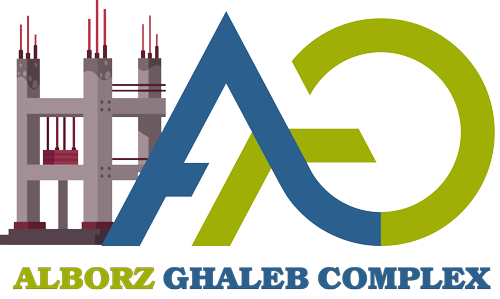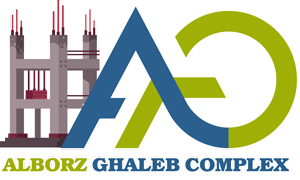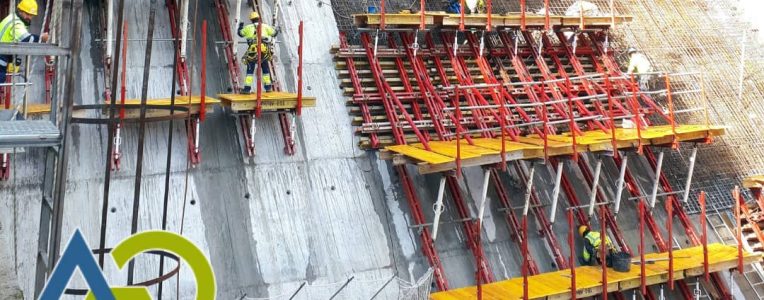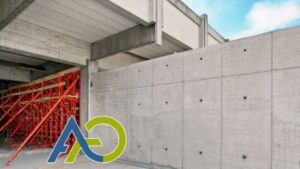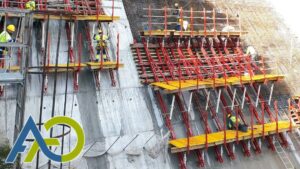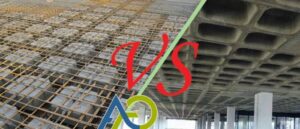Why Dam Concrete Formwork is Critical for Dam Construction Success?
Concrete dams are engineering marvels, pivotal for water management, hydropower generation, and flood control. The backbone of these structures is **dam concrete formwork**, which shapes the concrete while ensuring strength, precision, and durability.
Selecting the right formwork can reduce costs, speed up timelines, and elevate project quality. Alborz Ghaleb, a leader with over 20 years in concrete formwork offers this in-depth guide for engineers, contractors, and project managers. From types and technical features to 2025 cost estimates and selection tips, this article equips you with everything you need.
Ready to transform your dam construction projects? Dive in and explore how Alborz Ghaleb can support your success!
What is Dam Concrete Formwork? Definition and Evolution
Dam concrete formwork refers to a system of panels—constructed from metal, polymer, or wood—designed to mold concrete during dam construction. These systems must endure the hydrostatic pressure of fresh concrete (25–30 kN/m²), dynamic loads from vibration, and environmental challenges like humidity and extreme temperatures.
Formwork for dams traces back to the 19th century, with simple wooden forms. The 20th century brought metal formwork and advanced systems like climbing and slipform, enabling iconic projects like the Hoover Dam (USA) and Karun 3 Dam (Iran).
Modern dam construction relies on modular metal formwork, prized for its durability and reusability. Alborz Ghaleb delivers cutting-edge formwork solutions tailored to today’s engineering demands.
Types of Dam Concrete Formwork: Finding the Perfect Fit
Formwork systems vary based on dam type, construction method, and material. Here are the primary types:
1. Metal Formwork
Crafted from steel or aluminum, metal formwork offers unmatched strength and longevity (20+ years), ideal for gravity and arch dams. It’s been integral to projects like Iran’s Dez and Karun 3 dams.
Explore Alborz Ghaleb’s modular metal formwork for robust solutions.
2. Climbing Formwork
Climbing formwork is designed for incremental concrete pours at height, using hydraulic or mechanical jacks. It’s perfect for tall dam bodies, enhancing construction efficiency.
3. Slipform Formwork
Slipform systems move continuously, ideal for roller-compacted concrete (RCC) dams or uniform sections. They minimize construction time but require specialized equipment.
4. Polymer Formwork
Lightweight, affordable, and moisture-resistant, polymer formwork suits small or temporary projects. Learn about Alborz Ghaleb’s innovative concrete formwork.
5. Wooden Formwork
Cost-effective but less durable, wooden formwork is used in small-scale or temporary applications.
Technical Features of Dam Concrete Formwork: The Key to Quality
Top-tier formwork meets rigorous engineering standards. Essential features include:
- Strength: Resists concrete pressure (25–30 kN/m²) and dynamic loads.
- Durability: Withstands corrosion, humidity, and temperature swings (ACI 207 compliant).
- Precision: Dimensional accuracy (<3 mm deviation) for smooth, leak-free surfaces.
- Flexibility: Adaptable for complex arch dam sections.
- Safety: Includes protective systems for high-altitude work.
Alborz Ghaleb ensures safety with its system scaffolding, designed for demanding dam projects.
Production and Installation: From Design to Dam
1. Design
Formwork is engineered using tools like AutoCAD or Tekla, factoring in concrete pressure, slope angles, and section dimensions.
2. Production
Metal formwork is fabricated from ST37 steel with CO2 welding, while polymer forms are created via injection molding.
3. Installation
Installation uses heavy cranes and system scaffolding, ensuring worker safety and precision.
4. Concrete Pouring and Demolding
After pouring C30 or C40 concrete, formwork is removed after 7–14 days, ready for reuse.
Comparing Formwork Types: Metal, Polymer, or Wood?
| Type | Cost ($/m²) | Durability | Weight | Application |
|---|---|---|---|---|
| Metal | 50–100 | High (20+ years) | Heavy | Large dams |
| Polymer | 20–50 | Medium (5–10 years) | Light | Small dams |
| Wood | 10–30 | Low (1–3 years) | Medium | Temporary projects |
For large dams, choose Alborz Ghaleb’s modular metal formwork.
Dam Concrete Formwork Costs in 2025: Plan Your Budget
- Materials: Steel (100/m²), polymer (50/m²).
- Project Scale: Larger dams need custom forms.
- System Type: Climbing formwork costs 20–30% more.
- Installation: Cranes and labor (10/m²).
Get precise estimates with Alborz Ghaleb’s concrete formwork solutions.
Applications: From Karun 3 to Global Dams
- Gravity Dams: Like Dez Dam, using heavy metal formwork.
- Arch Dams: Like Karun 3, requiring precise forms.
- RCC Dams: With slipform for continuous pouring.
- Small Dams: Using polymer formwork.
Alborz Ghaleb offers tailored solutions for all dam types.
Advantages and Challenges of Dam Concrete Formwork
Advantages
- Durability: Metal forms last 20+ years.
- Speed: Climbing and slipform systems save time.
- Surface Quality: Smooth, seamless finishes.
Challenges
- Initial Cost: Metal forms are costlier than wood.
- Equipment Needs: Requires cranes and scaffolding.
- Design Complexity: Arch dams demand custom forms.
Alborz Ghaleb overcomes these with innovative, safe solutions.
How to Choose the Right Formwork: A Practical Checklist
- Dam Type: Arch dams need flexible forms.
- Budget: Metal forms are economical for large projects.
- Timeline: Slipforms for urgent projects.
- Environment: Metal or polymer for humid areas.
- Safety: Use system scaffolding.
Consult Alborz Ghaleb for expert guidance.
FAQs About Dam Concrete Formwork
What is climbing formwork?
What are 2025 formwork costs?
Metal vs. polymer formwork?
Are formworks reusable?
How is worker safety ensured?
Conclusion: Partner with Alborz Ghaleb for Dam Success
Dam concrete formwork is the foundation of every successful dam project. From modular metal formwork for large dams to versatile polymer options, Alborz Ghaleb delivers tailored solutions.
With concrete formwork and system scaffolding, execute your projects with precision. Visit Alborz Ghaleb today for a free consultation!
